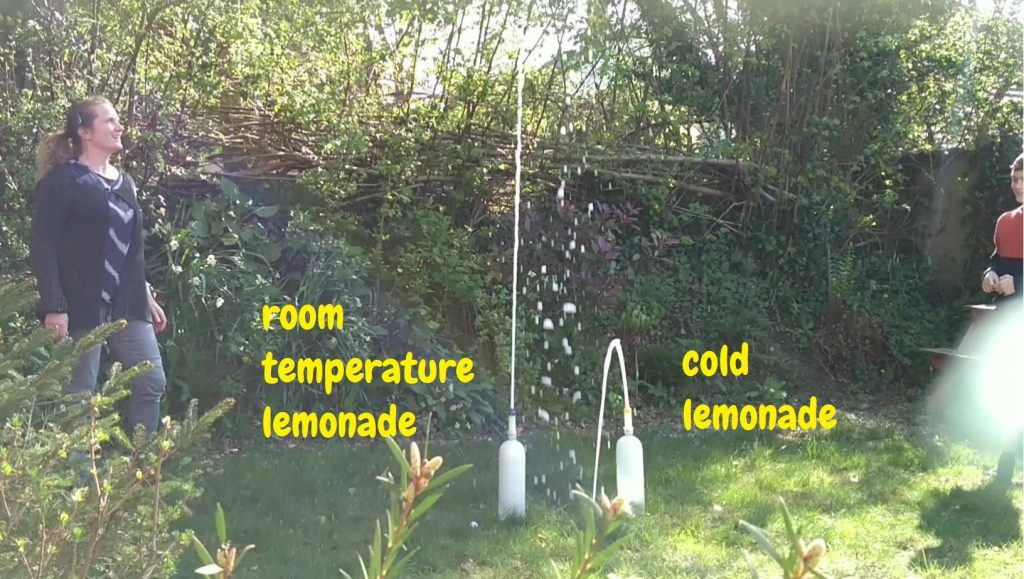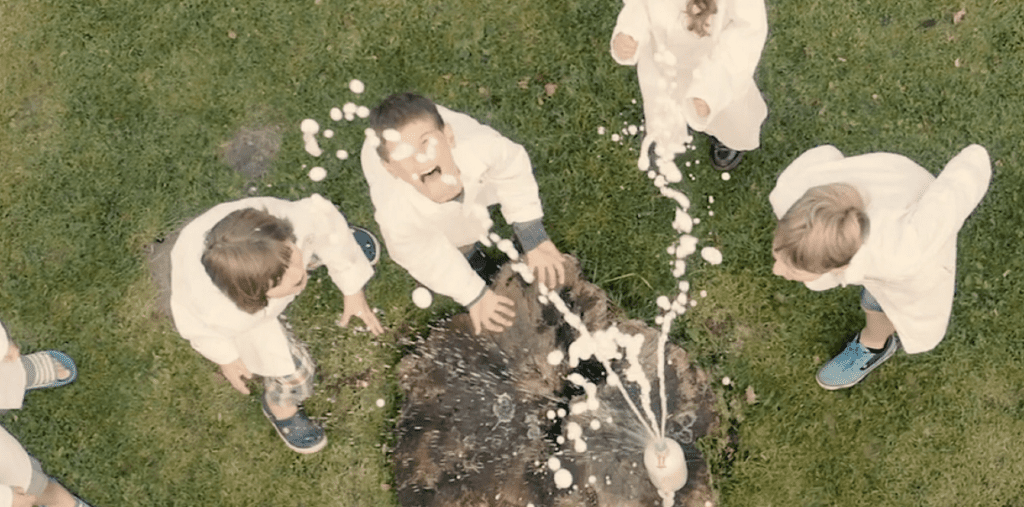There’s a problem with the Coke & Mentos experiment that few people know about and we want to share it with you! Check you’ve got the right ingredients, follow our tips, and then there’s one more thing that you should consider…….
Since 2005 the Coke & Mentos reaction has been wow-ing children and adults everywhere – when it goes well! Drop several Mentos into a bottle of coke or lemonade, and a huge eruption of bubbles shoots out several meters high. Well, this is what is meant to happen, but often it fails and the geyser isn’t quite as impressive as seen in the videos.

With this many children watching, its got to be right!

Impressively high, don’t you think?
Everyone wants a super-high explosion like this one!
Tips on a super-high coke geyser
You can get a super-high geyser, but first, check you’ve got the right kit:
- Are you using the correct drink with your Mentos Mints? Fizzy drinks such as coke or lemonade are the best but not carbonated water, for example.
- Drop in at least 5 mints at once – too few and the reaction is less impressive.
- Ensure you use a 2L bottle of drink, smaller bottles don’t work – they don’t have enough CO2 in them to make a good geyser.
- We prefer diet drinks to regular ones as they contain less sugar. Therefore, you won’t get covered in a sticky sugary mess. They also explode higher as they are less viscous.
So, you’ve got the right kit, but still are not getting a huge explosion every time?
Have you thought about the temperature of the drink?
Aha!!
We have to get it right every time, as you can see……
What not many people think about.
Temperature is a really important factor in this experiment, and it is rarely mentioned in tutorials and videos.
Our experiments have confirmed that cold bottles of coke and lemonade, straight out of the fridge, do not work very well at all, really disappointing results. They produce a small eruption and the reaction is much slower compared to drinks that are at room temperature. Bottles warmed up in the sun, or by a radiator work the BEST!
Check out our image below, and yes, we dropped the Mentos in at the same time!! The drink on the right had just come out of the fridge (we cooled the Mentos too), and the one on the left was at room temperature – what a difference!

We made a video too….don’t pick a lemonade fight with a kid, you’ll always lose!
Why does temperature matter?
At warmer temperature CO2 gas particles (and other molecules) have more energy. Therefore, the particles move faster and want to escape the liquid they are dissolved in quickly compared to cooler temperatures. When its warmer, gas doesn’t dissolve well in liquids and is more likely to escape from a liquid it is dissolved in (this is called Henry’s Law). Try cracking open a can of warm fizzy drink and compare it to one just from the fridge!
How does the Coke & Mentos reaction work anyway?
A 2 Litre bottle of coke or lemonade have 8 litres of CO2 dissolved in them. Have you noticed, your fizzy drink has tiny bubbles appearing on the side of the glass at a particular spot? This is because bubbles form on tiny pits on the surface of a container. These imperfections are called nucleation sites. On your glass, there are fine imperfections which act as nucleation points where the bubbles can form and escape. Mentos have hundreds of tiny imperfections (nucleation sites) on their surface. Dropping Mentos into coke or lemonade allows the dissolved gas within the liquid to come out of the liquid super-fast at these nucleation points on the Mentos surface. Thus the Coke and Mentos reaction is a physical one, not a chemical reaction.
Want more easy science guides?
Head on over to our blog to find out other cool experiments such as Glowing Fluorescent Liquid or the Super Easy 6 – a free download with 6 super-easy experiments to try at home!
Click here for the perfect slime.
You can also check out the award winning science workshops that are coming up in Devon, why not book on?
If you try these activities at home you do so at your own risk.
Happy science-ing
Ruth
Chief Scientist
Sciencedipity

